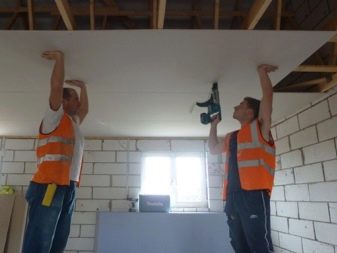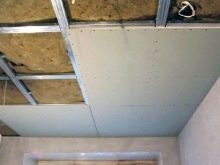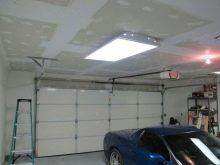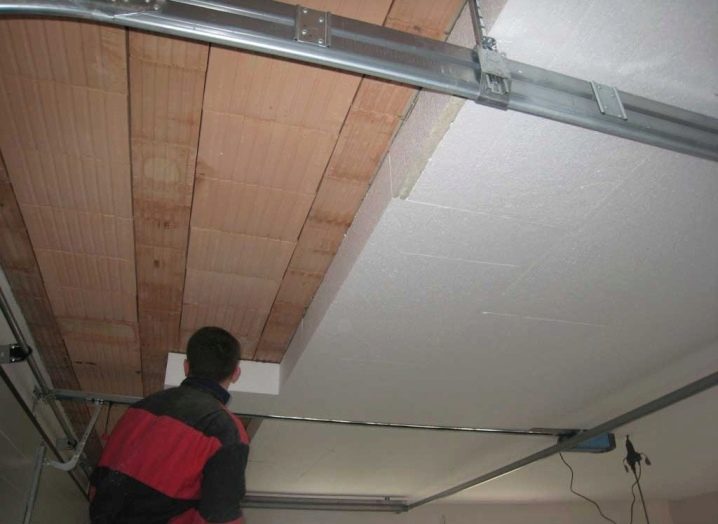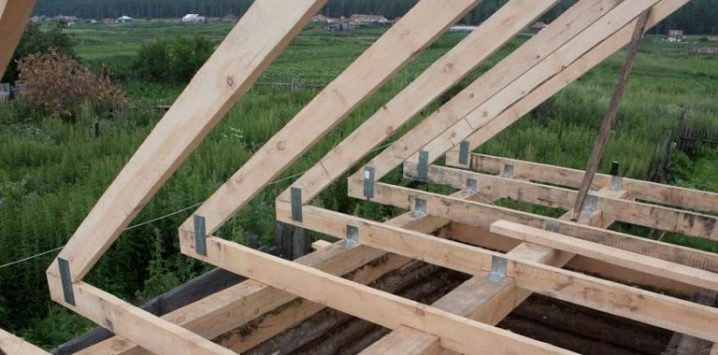The ceiling in the garage: what and how to do?
The garage is traditionally a box for repairing and parking a car, however, this room can additionally be used as a storeroom, cellar or even a small recreation area. Variants of its construction and design can vary greatly both in materials and technologies, so there is no single way to finish garage surfaces, including the ceiling. Much depends on the budget, building material and personal taste.
Special features
Most often, garages are built with a flat roof with large concrete masses divided by partitions of the same material. Finishing in this case allows you to hide a not very decorative concrete surface, warm the room and give the space a certain style. There may be frost and condensation on the concrete, and trim will help to avoid moisture dripping from the ceiling onto the car. In addition, the garage room can also be used to equip a residential area in a loft-style or a small workshop for an artist or carpenter.In these cases, the ceiling can be not only concrete, but also wooden or even metal.
The ceiling of the garage performs not only a decorative function, it installs a variety of lamps that will be needed for maintenance or repair of the car. For headlining the ceiling, they use both traditional boards, drywall or plaster, as well as modern technologies that require a certain level of skill. The garage should be warm, with good ventilation and well-designed electrical wiring.
How to sheathe?
First, you need to choose a material for the ceiling plating itself, it should have not only decorative properties, but also protect it from moisture or a sharp increase and decrease in temperature. The material should not be exposed to aggressive substances such as fuel or brake fluid. If there is no additional heating in the garage, you should warm the ceiling using suitable materials. The most suitable for this are:
- foam insulation;
- penoplex;
- polystyrene foam;
- mineral wool.
One of the most common options for finishing the garage ceiling are:
- wet plaster;
- drywall;
- PVC panels;
- OSB, DVP or MDF.
Ceiling finish wet plaster It has been popular for many years due to its reliability and durability. The process of registration is divided into stages of spraying, priming and covering. To date, this method of finishing the ceiling is practically not used, although it is cheap, since it is quite labor-intensive and energy-intensive.
In place of the plastered ceiling came option from drywall. This finish is done quickly and easily by hand using galvanized profiles and low-cost plasterboard sheets. The material perfectly hides the irregularities of the ceiling and allows you to disguise communication. The damaged area is easy to replace, and the material itself is environmentally friendly and safe, but unstable to moisture and "eats" at least 4-5 cm in height of the ceiling.
It is possible to sew up PVC panels (clapboard) on the frame of the timber, make the lining with the help of a professional sheet. Lining more moisture-resistant, it is resistant to fire and is easy to clean with plain water. Simplicity of filing will save on the services of professionals and reduce repair costs. Unfortunately, PVC panels are quite fragile: direct mechanical impact or impact can break them into pieces.
Recently, besides the already familiar wooden or PVC lining, they use planken. These are boards with hewn edges from 7 to 14 centimeters wide, which are laid out on the batten both horizontally and vertically.
In cases where practicality is more important than decoration, you can hem the ceiling OSB, fiberboard or various glued materials of pressed wood shavings. Oriented strand board, unlike other products, is impregnated with resins and paraffin at the production stage, as a result of which it acquires increased moisture resistance and does not need an additional protective coating. Such plates are environmentally friendly, easy to install and are adapted for further painting in any color.
However, with all its moisture resistance, the edges of such plates remain susceptible to destruction under the influence of moisture, and they require additional protection.
Dimensions
For a comfortable stay and work in the garage, the ceiling height must be at least 2 meters. However, if you plan to trim the ceiling with plasterboard or plywood, then the height should be at least 2.5 meters. In order to choose the right ceiling height from all the options, it is necessary to consider the following parameters:
- vehicle height;
- free space above the car (200-300 mm);
- place under the lighting;
- height of the garage door.
Installation design
Ceiling sheeting with wooden or PVC lining, sheeting, OSB or plaster finish is not particularly difficult. Making the ceiling in such ways in the garage is carried out according to the instructions and is no different from work carried out in any other room. It is necessary to pay close attention to the installation of the frame of wooden barssecurely attached to concreted walls or ceiling. It is better to hang metal corners on the walls, which are attached with anchor bolts.
As an alternative to the listed finishing methods, you can install a suspended or suspended ceiling.
The suspended ceiling is suitable for high rooms and requires quite a lot of financial resources. Suspended construction lowers the ceiling by 150-200 mm due to the mounting features of the aluminum frame. However, due to the same frame, there is an additional opportunity to hide the location of electrical wiring for lamps and sockets, ventilation, or a lift system for automatic garage doors.
Another option for finishing the ceiling of the garage is a tension option.This method is chosen infrequently, due to the inconvenience of its operation. Most often, these ceilings are used in heated garages, combined with the residential part of the house. The advantage of the tension structure is the speed of installation and high decorative coating.
Warming
It is not enough just to concrete and sheathe the ceiling and walls of the garage, they also need to be insulated to prevent the occurrence of drizzle and condensation in such a small closed room. For thermal insulation, you can use:
- mineral wool;
- Styrofoam;
- glass wool.
In the case of foam, the material must be applied glue. Then the sheet must be glued to the ceiling, fastened with dowels and eliminate all gaps using foam. Then you can proceed to plastering.
In the case of mineral wool or fiberglass, insulation must be placed between the bars of the frame, and then fix the wall paneling or fiberboard.
Waterproofing
In the garage quite often you can see the drips of water on the walls and on the ceiling of the building. This indicates not only the non-observance of technology at the construction stages, but also the formation of condensate on the ceiling, due to the sharp temperature drop and freezing of the roof material. To get rid of the ingress of water into the garage is desirable, of course, to eliminate the causes themselves.
However, sometimes this can lead to the dismantling and complete replacement of not only the roofing, but also the roof ceilings themselves. If it is possible to localize the damage site, then it is best to completely perform a spot repair. In other cases, in order to save produce waterproofing the ceiling from inside the room with the following options:
- roll materials;
- coating mixtures;
- injection waterproofing.
Rolled materials are most often used for waterproofing from the outside and are not suitable for tamping the ceiling indoors. Injection hydro and vapor barrier is quite an effective method. With the help of injections of a special solution, various microcracks and voids in the structure are filled. The disadvantage of this method is the need to purchase expensive professional equipment or pay for the work of specialists.
Coating insulation is a mastic that is applied in one or several layers on the prepared surface of the ceiling.Drying out, such mastic turns into a solid film that does not allow moisture and steam to pass through. However, in garages that are waterproofed with pasting mastic, Additional installation of forced ventilation is necessary for the exhaust gas and various fumes.
Lighting
When planning the decoration of the ceiling and its insulation, you should not forget about high-quality lighting. Usually in the garage lighting devices are installed not only on the ceiling, but also on opposite walls. Each such device must be switched on and off separately in order to respond to the functionality of the room; it is not recommended to use the “carry” in the garage.
If the ceiling will be made out with the help of a rack or a suspended structure, they can be easily combined with thin modern lamps. Such sources of illumination almost do not heat up, their lifespan implies usage for 10,000 hours. With their help, electricity is significantly saved.
In a stretch ceiling, spotlights look good, however, it is necessary to avoid overheating of the case in order not to damage the PVC film. You can also use various energy-saving, LED lamps or even make special pendant lights yourself:
- pull the string wire without sagging at a distance of 1 m along the wall and fix;
- lamps are suspended on the resulting line with the help of wire bent in the shape of the letter S;
- The cable is fastened to the hooks with electrical tape.
The creation of such structures in different parts of the room will illuminate even the darkest corners of the garage.
Useful recommendations
If the ceiling in the garage is metal, then it must be insulated and waterproofed using foil-coated materials. They are fixed with a stapler or glue on the frame of corrugated board. The ceiling can be simply painted with water-based paint. To do this, the surface should be cleaned, leveled and dried.
The timber frame of the batten must be pre-treated with antiseptics to protect against rodents and insects, which often appear in the garage. You can also use a metal profile to create a skeleton, it is more durable and less susceptible to the effects of aggressive media or rodents.
Regardless of the material chosen, great attention must be paid to correct installation. It is not recommended to save on fixing materials and ignore the recommendations of various specialists, and then the skin will not require repairs and will last for many years.
The following video shows how to sheathe the ceiling in the garage.










